- 2LP
- Digital
Yutaka Hirose
TRACE: Sound Design Works 1986-1989
WRWTFWW Records
- Cat No: WRWTFWW066
- Release: 2022-09-16
- updated:
世界から注目された80年代の日本の環境音楽から、新たな素晴らしい音源が発掘されました。芦川聡のSound Process Designで制作された広瀬豊のレアワークス。
Track List
-
1. Yutaka Hirose - Reflection
07:49 -
2. Yutaka Hirose - Fluctuation
05:08 -
3. Yutaka Hirose - Light From Clouds
06:10 -
4. Yutaka Hirose - Air To Feel Outside
12:39 -
5. Yutaka Hirose - Inner Voice
11:26 -
6. Yutaka Hirose - Looking Back
09:13 -
7. Yutaka Hirose - The Breath Of Cyberspace
06:25 -
8. Yutaka Hirose - Babel's Library
07:52 -
9. Yutaka Hirose - Cross Section Of The Underground
05:35 -
10. Yutaka Hirose - Voice From Past Technology
10:26 -
11. Yutaka Hirose - Study For Scientists
05:50
16bit/44.1khz [wav/flac/aiff/alac/mp3]
WRWTFWW Records couldn't be happier to announce the release of Yutaka Hirose's never-heard before 11-track collection TRACE: Sound Design Works 1986-1989.
TRACE is a collection of 11 unreleased tracks produced by Yutaka Hirose between 1986 and 1989, during the Sound Process Design sessions, right after the release of his classic Soundscape series album Nova. Sound Process Design was Satoshi Ashikawa's label, home of the Wave Notation trilogy (Hiroshi Yoshimura's Music For Nine Postcards, Satsuki Shibano's Erik Satie 1866-1925 and Satoshi Ashikawa's Still Way). Following Wave Notation, Sound Process Design worked with museums, cafes and bars to create site-specific soundscapes, starting with the sound design of the Kushiro Museum. Yutaka Hirose was called to work on these projects.
Rather than simply providing pre-recorded compositions, Hirose sought to create a "sound scenery". To achieve this, he participated in the conception of the space and paid particular attention to the accidental combination of sounds by placing the speakers, using a multi-sound source, and following the concept of "sculpturing time through sound".
The composer explains: "sculpturing time through sound means that time, the space itself, the sound played in it, and the audience all become one sculpture. It is close to the idea of a Japanese tea ceremony where you use all of your 5 (or 6) senses to taste the tea."
TRACE: Sound Design Works 1986-1989 is divided into two parts. The Reflection segment is based on an ambient soundscape. It narrates "a sleep that starts with the sound of water droplets at dawn and slowly disappears into darkness" and feels like a natural and soothing progression of Nova. It was played in entrance halls, at events, in cafes and bars. The Voice from Past Technology segment expresses the dream world born out of that sleep and is based on what Yukata Hirose calls hardcore ambient, environmental music with a noise approach. It was played in museums and science centers.
All in all, TRACE is a crucial addition to every Japanese environmental music fan's collection, alongside Midori Takada's Through The Looking Glass, Hiroshi Yoshimura's Green, Satoshi Ashikawa's Still Way, Motohiko Hamase's Notes of Forestry, Inoyamaland's Danzindan-Pojidon, and Yutaka Hirose's very own Nova.
TRACE is a collection of 11 unreleased tracks produced by Yutaka Hirose between 1986 and 1989, during the Sound Process Design sessions, right after the release of his classic Soundscape series album Nova. Sound Process Design was Satoshi Ashikawa's label, home of the Wave Notation trilogy (Hiroshi Yoshimura's Music For Nine Postcards, Satsuki Shibano's Erik Satie 1866-1925 and Satoshi Ashikawa's Still Way). Following Wave Notation, Sound Process Design worked with museums, cafes and bars to create site-specific soundscapes, starting with the sound design of the Kushiro Museum. Yutaka Hirose was called to work on these projects.
Rather than simply providing pre-recorded compositions, Hirose sought to create a "sound scenery". To achieve this, he participated in the conception of the space and paid particular attention to the accidental combination of sounds by placing the speakers, using a multi-sound source, and following the concept of "sculpturing time through sound".
The composer explains: "sculpturing time through sound means that time, the space itself, the sound played in it, and the audience all become one sculpture. It is close to the idea of a Japanese tea ceremony where you use all of your 5 (or 6) senses to taste the tea."
TRACE: Sound Design Works 1986-1989 is divided into two parts. The Reflection segment is based on an ambient soundscape. It narrates "a sleep that starts with the sound of water droplets at dawn and slowly disappears into darkness" and feels like a natural and soothing progression of Nova. It was played in entrance halls, at events, in cafes and bars. The Voice from Past Technology segment expresses the dream world born out of that sleep and is based on what Yukata Hirose calls hardcore ambient, environmental music with a noise approach. It was played in museums and science centers.
All in all, TRACE is a crucial addition to every Japanese environmental music fan's collection, alongside Midori Takada's Through The Looking Glass, Hiroshi Yoshimura's Green, Satoshi Ashikawa's Still Way, Motohiko Hamase's Notes of Forestry, Inoyamaland's Danzindan-Pojidon, and Yutaka Hirose's very own Nova.




吉村弘が第1弾を務めたミサワホーム総合研究所のサウンドスケープ・シリーズの第2弾「Soundscape 2: Nova」の再発に続いて、Yutaka Hirsoe(広瀬豊)のレアワークス、未発表音源をコレクトした「Trace: Sound Design Works 1986-1989」がリリースされました。『NOVA』をリリースした直後に、釧路博物館を皮切りに、さまざまな場所の音響を手がけた芦川聡のSound Process Designで制作された11の楽曲。『単に録音された楽曲を提供するのではなく、「音の風景」を作り上げることを目指し、空間の構想から参加して、スピーカーの配置やマルチ音源による音の偶然の組み合わせにこだわり、「音で時間を彫刻する」というコンセプトを貫いた。』『"sculpturing time through sound "とは、時間、空間そのもの、そこで奏でられる音、そして観客のすべてがひとつの彫刻となることを意味します。それは、日本の茶道で五感(または六感)を使ってお茶を味わうという考え方に近いと思う。』とか祟られている。日本産環境音楽の素晴らしいサウンド。2LP、見開きスリーヴ、ライナーノーツつき。アナログ発売後即完売してましたが、若干数ストックできました。 (サイトウ) (2LPのコメントから参照)